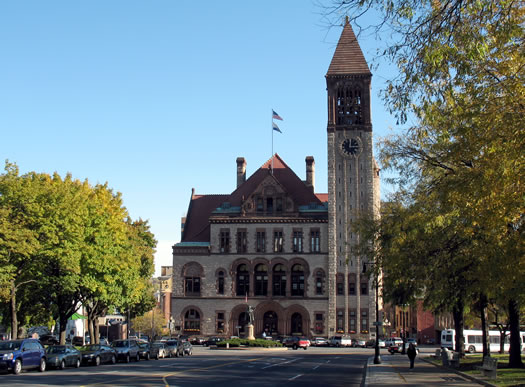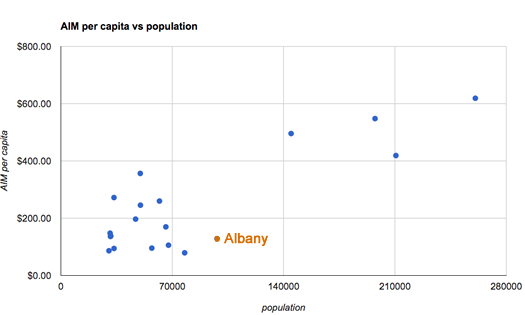Is Albany getting the short end of the stick?

The amount of aid the state distributes to cities might sound like a topic straight out of Snoresville, but it's an important -- and recurring -- topic related to Albany's finances. And Albany's finances are related to all sorts of other topics that do get a lot more attention: stuff like taxes and new development.
For years, Albany leaders have argued that city gets hosed on the amount of municipal aid the city gets from the state, especially compared to other large upstate cities. And, in the annual tradition, Kathy Sheehan has been raising this point again as the machinery of the state government budget process starts whirring. Over at the Times Union, JCE recently had an article detailing some of the mayor's arguments that Albany should be getting more from the state.
The longtime argument in favor of Albany getting more state aid has essentially boiled down to this point: When compared to other large upstate cities, Albany gets much less in aid per capita.
So, with the topic in circulation again, we figured it'd be interesting to look at exactly that -- how much the capital city is getting per capita versus other cities.
A few important details
The money
The state aid we're looking at in this case is called "Aid and Incentives for Municipalities" -- or, as pretty much everyone refers to it, AIM. Here's the list of AIM figures from the 2014-2015 enacted state budget.
The population
The population figures we used are from the Census Bureau's 2013 American Community Survey 5-year estimates. So, some grains of salt: These are estimates, and they're not super recent.
More grains of salt regarding the poverty numbers: The Census Bureau estimates are based on a portion of the population for which poverty status could be determined during the previous 12 months. That population is often smaller than the total population of the municipality. Example: Estimates have Albany pegged at about 98,000 residents, but the poverty estimate is based on a population of about 88,000 people. So the number of people in poverty might be a bit of an underestimation.
AIM per capita
This is a table of upstate cities with AIM per capita and AIM per capita people in poverty. The best apples to apples comparison is going to be between cities of similar size, so we've sorted the table by total population. (Cities in the Capital Region core are highlighted.)
The state doesn't restrict AIM just to cities -- towns and villages also get it -- some 1,500 municipalities in total. If you're curious, here's a spreadsheet of the whole list.
Another view of the numbers
So, is Albany an outlier? Well, one way to get a sense of that is to graph the upstate cities with populations of 30,000 or more (in an attempt to compare similar types of apples*) and their AIM per capita versus their population:

* And even these apples -- to continue stretching the metaphor -- aren't the same. A city like Buffalo (261k residents, #1 in upstate city population ranking) is very different from, say, Ithaca or Elmira (#19 and #20, with about 30k residents). Albany occupies a sort of middle ground, almost by itself, between those two ends of the spectrum.
So...
When compared to other large upstate cities, Albany's per capita AIM funding is relatively low -- both for total population, and number of people in poverty -- especially compared to the larger cities.
Of course, one of the counter-arguments to Albany getting more state funding is that, as the capital, Albany already benefits greatly from the state. Some of this benefit is explicit -- Albany gets about $15 million a year as payment for lost tax revenue on land used for the Empire State Plaza. And there are other benefits such as jobs and generated economic activity from state offices.
But there's also the counter-counter-argument: Well, Albany doesn't get any payment for the Harriman campus land, which is important because so much of the city's land is non-taxable. And, yeah, there are a lot of state jobs -- but a lot of those people don't live in the city.
As mentioned, this back-and-forth has been going on for years. It'll be interesting to see if the Sheehan administration can find a new way of arguing it -- she's talked in the past about gathering data to cast the situation in a new light -- and whether the Cuomo admin and legislature will be receptive.
Hi there. Comments have been closed for this item. Still have something to say? Contact us.
Comments
Great analysis, and kinda shocking how far behind Albany really is on that.
One thing I'd be curious about is what that $15M for the Plaza means in terms of what revenues are foregone. If those blocks had continued to be like Center Square, what property taxes would they be bringing in? I just don't know how that compares.
... said Carl on Jan 7, 2015 at 5:37 PM | link
Why shouldn't Albany get compensated for the Harriman land? That's prime real estate. Just think if Crossgates had been built on the Harriman land instead of in Guilderland. Albany residents would be paying much lower property taxes. It would be at least better if Harriman was built into the existing neighborhood but it's not. It's a self-contained island where commuters drive in and then drive out. There are no restaurants, stores, etc. next to the Harriman that are in the city limits, so Albany doesn't get any revenue from it. If Crossgates is an extreme example, just think if that would have been a normal neighborhood with houses similar to the adjacent Melrose neighborhood. Homes there average around $180,000 in value and pay about $6,000 a year in taxes. It would still be better financially for the city.
... said Paul on Jan 8, 2015 at 8:59 AM | link
Guys, the ship sailed 50 years ago on the Plaza and Harriman. If we keep wishing on the benevolence of the state we're never going to improve this town.
... said dasmb on Mar 22, 2016 at 6:19 PM | link